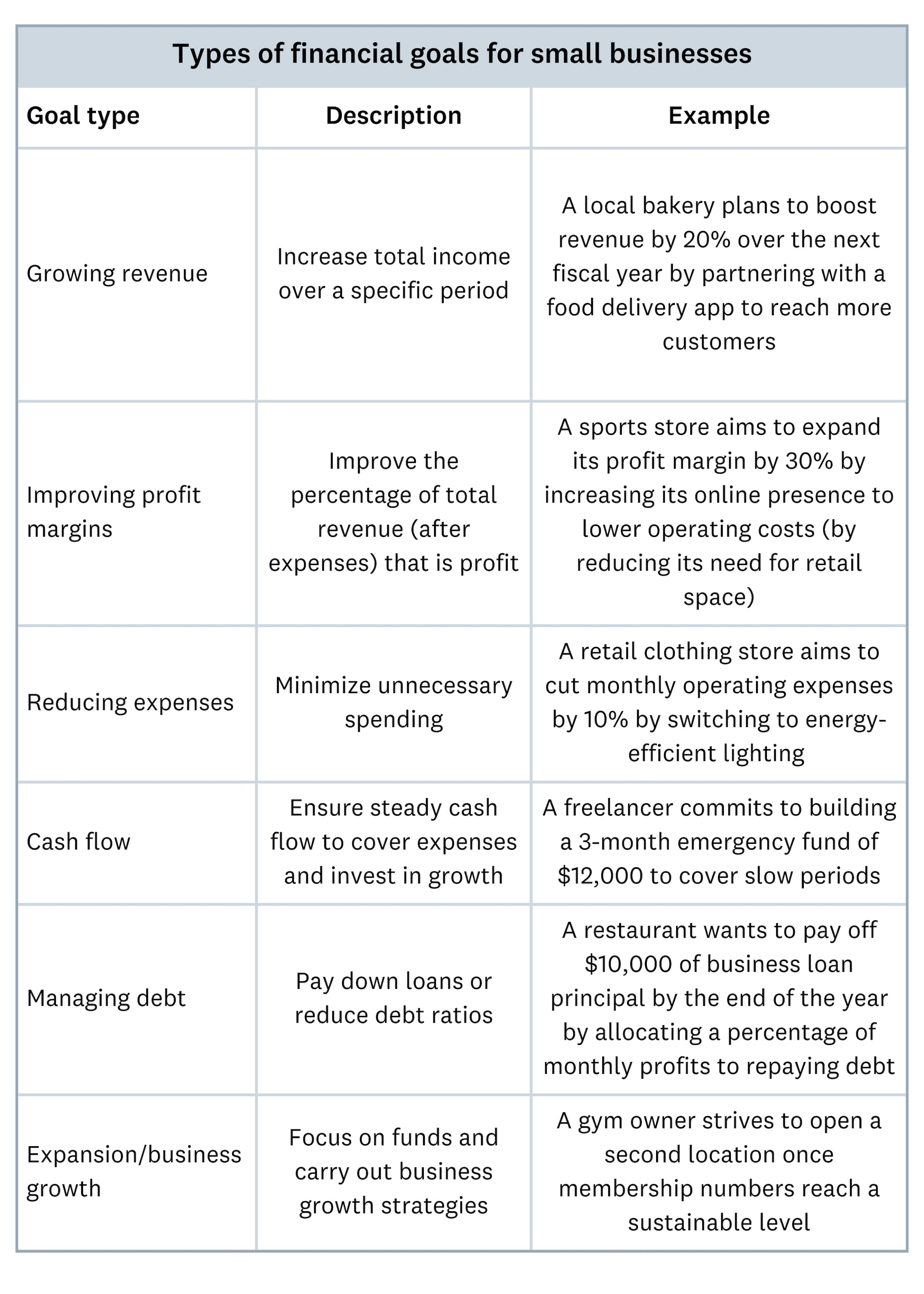How to set financial goals for your business
Learn how to set SMART financial goals, track key metrics, and use the right tools to boost your bottom line.

Table of contents
- Why are financial goals important?
- Types of financial goals for small businesses
- How to set SMART financial goals for your business
- Tools to achieve your financial goals
- FAQs about setting financial goals
Key takeaways
- Setting clear financial goals helps small businesses make focused decisions, allocate resources effectively, and improve the chances of success.
- Growing revenue, improving profit margins, reducing expenses, managing cash flow, paying down debt, and expanding operations are key financial goals to aim for.
- Using the SMART framework—Specific, Measurable, Achievable, Relevant, and Time-bound—ensures goals are clear, realistic, and trackable.
- Budgeting software, accounting platforms, goal-tracking apps, and dashboards help businesses monitor progress and stay on track.
Why are financial goals so important?
A solid small business financial strategy begins with the goals that guide your decisions and allocate resources where they’re needed most. Without goals, your decisions can lack focus and direction, and your small business is less likely to succeed.
But you’re much more likely to make progress if you set clear, well-defined financial goals that your business can realistically achieve. If you set a goal to increase annual revenue by 20%, for example, this can focus your attention on specific, result-driven strategies to achieve it, like:
- Retaining more customers by starting loyalty programs
- Launching new products into market gaps to attract buyers
- Running targeted marketing campaigns to boost sales
Types of financial goals for small businesses
This table below breaks down some of the main types of financial goals a small business owner should think about, along with some real-world examples.
These financial areas are most directly related to your business’s overall financial wellbeing. The metrics you’d use to measure goals in these areas are most likely to help you track progress and make decisions that affect your business's financial health. These focused goals allow your business to identify specific areas of potential growth and thereby foster continued success.

Set SMART financial goals for your business
Using the SMART formula is perhaps the best business goal setting tip out there. It’ll help you define your goals in each of the categories above, in a way that focuses your business on achieving them.
Let’s say your financial goal is to boost profits – while it’s a solid business objective, it’s a bit vague.
Instead, you need a clear, tangible target that shows exactly what you’re working towards, how you’ll get there, and what success looks like.
To achieve this, your goals should be SMART:
- Specific – define your goals clearly
- Measurable – include quantifiable metrics to track your progress
- Achievable – set goals that are realistic and based on your circumstances
- Relevant – align your goals with broad business objectives
- Time-bound – Set deadlines for your goals so you stay accountable
How to set SMART financial goals
You can apply the SMART framework to each financial goal with this simple formula:
I want to [specific goal] by [timeframe] so that [relevant outcome]. I will measure success by [metric].
A real-world example might look like this:
I want to boost profits by 15% within 1 year so I can invest in a new factory to significantly boost my capacity. I will measure success by tracking monthly profit margins, reducing my operating costs by 10%, and increasing high-margin product sales by 20%.
Looking at it through the SMART lens, the goal is:
- Specific – boost profits by 15%
- Measurable – profit margins will be tracked monthly
- Achievable – cutting costs and focusing on high-margin products seems like a good way to drive a 15% profit increase
- Relevant – aligns with the business’s broader goal of building a new factory to expand production (see more tips for growing your business)
- Time-bound – has a clear 1-year deadline
This goal meets all the criteria of the SMART framework.
Once you’ve developed your goals with SMART, you’ll have a set of goals that are easy to track when looking at your overall KPIs(key performance indicators) for your small business – specific results for your work that your business needs to achieve.
Tools to help you achieve your financial goals
The right tools give you the data you need to support your business decisions, andhelp keep you on track to achieve your financial goals.
Look for tools in these four categories:
- Budgeting software – budgeting helps you allocate resources and keep your spending on track
- Accounting platforms – cloud-based accounting software is a great way to track your cash flow in real time and manage your financial admin to collaborate with your accountant in real time
- Goal-tracking apps – break down financial targets into manageable steps and monitor your progress with tools like Asana and Trello
- Dashboards – track key financial metrics like revenue, profit margin, and cash flow, and visualize them with graphs and graphics that help you home in on essential information
Xero’s cloud-based accounting software lets you track your progress against the key metrics you choose. Its advanced tools give you the data to support your goal setting, then track your progress against your goals on your own personalized dashboard.
FAQs about setting financial goals
Check out these FAQs to help you more easily set and achieve your financial goals:
1. How will my financial goals affect the growth of my business?
Your financial goals directly affect your business’s growth by guiding strategic decisions, like resource allocation. Clear financial goals help you measure progress, improve cash flow management, and identify opportunities for expansion. You may struggle to make decisions that drive your business forward without a clear target for long-term success.
2. What’s the difference between short-term and long-term financial goals?
Short-term goals are typically achievable within a few months to a year. Long-term goals extend beyond a year and can even span several years. Set short-term goals for quick wins, immediate focus, or to break down larger objectives. Use long-term goals to guide strategic planning and work toward bigger ambitions over time.
3. Should I change my financial goals over time?
Of course! Keep your financial goals flexible, and be ready to adjust them if your business’s situation changes or there are shifts in the market, for example.
4. How often should I review my financial goals?
You can reassess them as often as you like. Ideally, though, you should review them at least quarterly – this is a good interval for monitoring performance and adjusting things in response to changes in your business or to the broader market.
5. What are common mistakes to avoid when setting financial goals?
Quite simply: the biggest mistake is setting goals that aren’t SMART. Vague goals with unrealistic expectations that don’t relate to your business circumstances – and then, failing to track progress – can lead to poor decisions. You and your team are much more likely to achieve goals that are SMART – specific, measurable, achievable, realistic, and time-bound.
6. How can I involve my team in achieving our financial goals?
It’s all about communication, engagement, and tracking progress. First, be clear with your team about the specific objectives you’ve set, why you’ve set these goals, and how you plan to achieve them (this is much easier if you’ve used the SMART formula to set clear, achievable goals). Then assign specific responsibilities to your team members with your goals in mind. Finally, monitor your team’s performance to keep everyone engaged and moving in the same direction.
7. How do I set financial goals during uncertain economic times?
When times are tough, it’s best to put your business’s financial stability first – so set goals that focus on maintaining and managing your cash flow. Make sure you’re not investing in any long-term costs that are not essential. This will ensure you’re not taking away from any positive cash flow until the hard times have passed. Have a look at your existing financial goals too – you might need to rethink them if changing economic conditions have made them unrealistic, say.
8. What metrics should I use when tracking financial goals?
It depends on several things like Xero is a great option. It gives you tools to measure your financial performance, and analytics to help you forecast your performance against your financial goals. It also helps you streamline your business admin, and set and manage your budgets.
: the nature of your business and its unique circumstances, your specific goals, the industry you’re in, and market conditions. In general, though, you should measure your revenue growth, profit margins, cash flow, and cost reduction strategies. Your financial advisor or accounting professional can help you identify the most useful and important metrics for your business.
9. Do I need a professional to help me set financial goals for my small business?
It’s not required, but it’s a great idea to have a professional set financial goals for your small business! A financial advisor or accountant has expertise and experience that can help you set goals that are realistic and achievable for your business.
10. Are there tools to help me track progress against my financial goals?
Yep! Accounting software
Disclaimer
Xero does not provide accounting, tax, business or legal advice. This guide has been provided for information purposes only. You should consult your own professional advisors for advice directly relating to your business or before taking action in relation to any of the content provided.
Start using Xero for free
Access Xero features for 30 days, then decide which plan best suits your business.